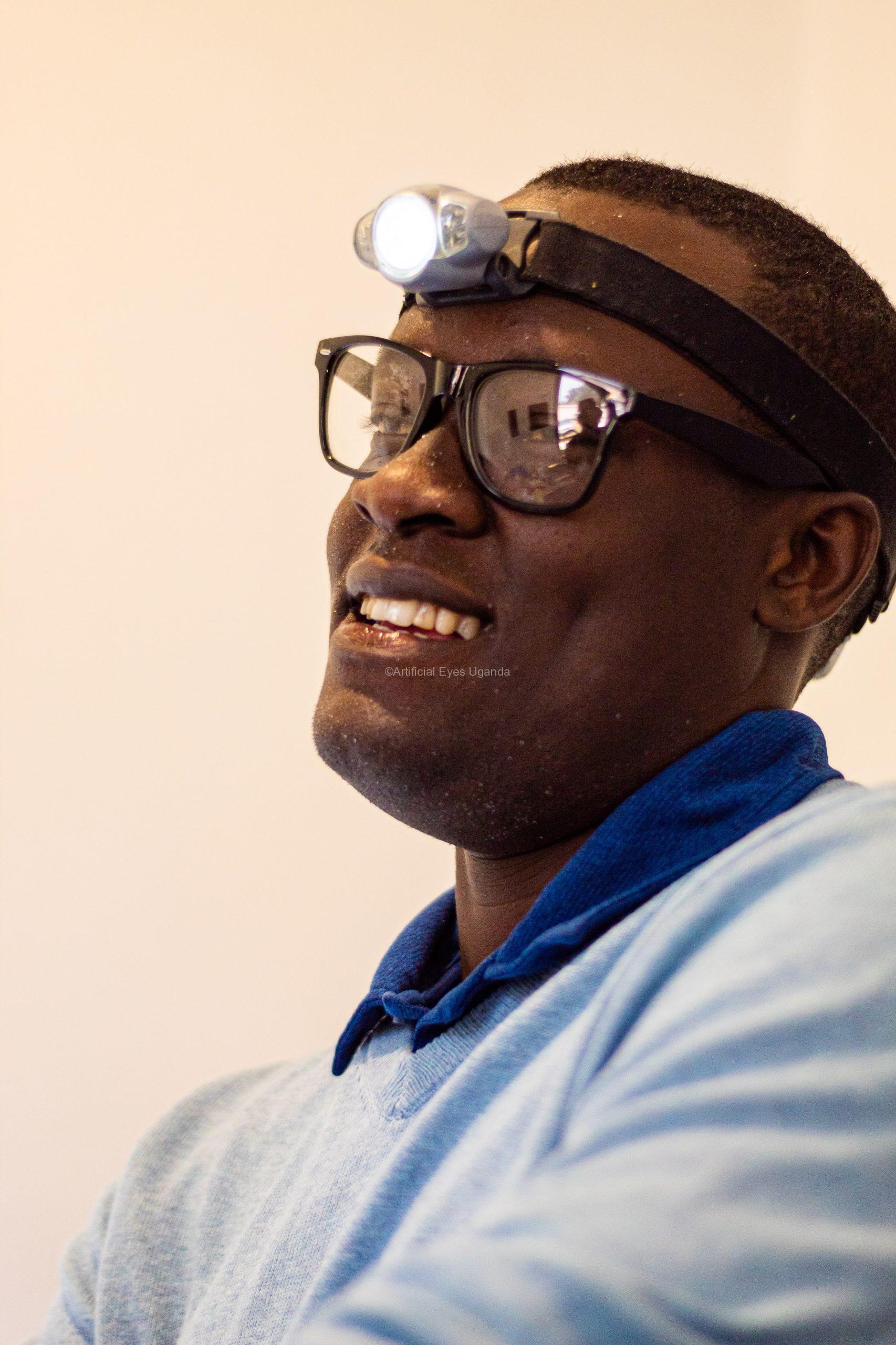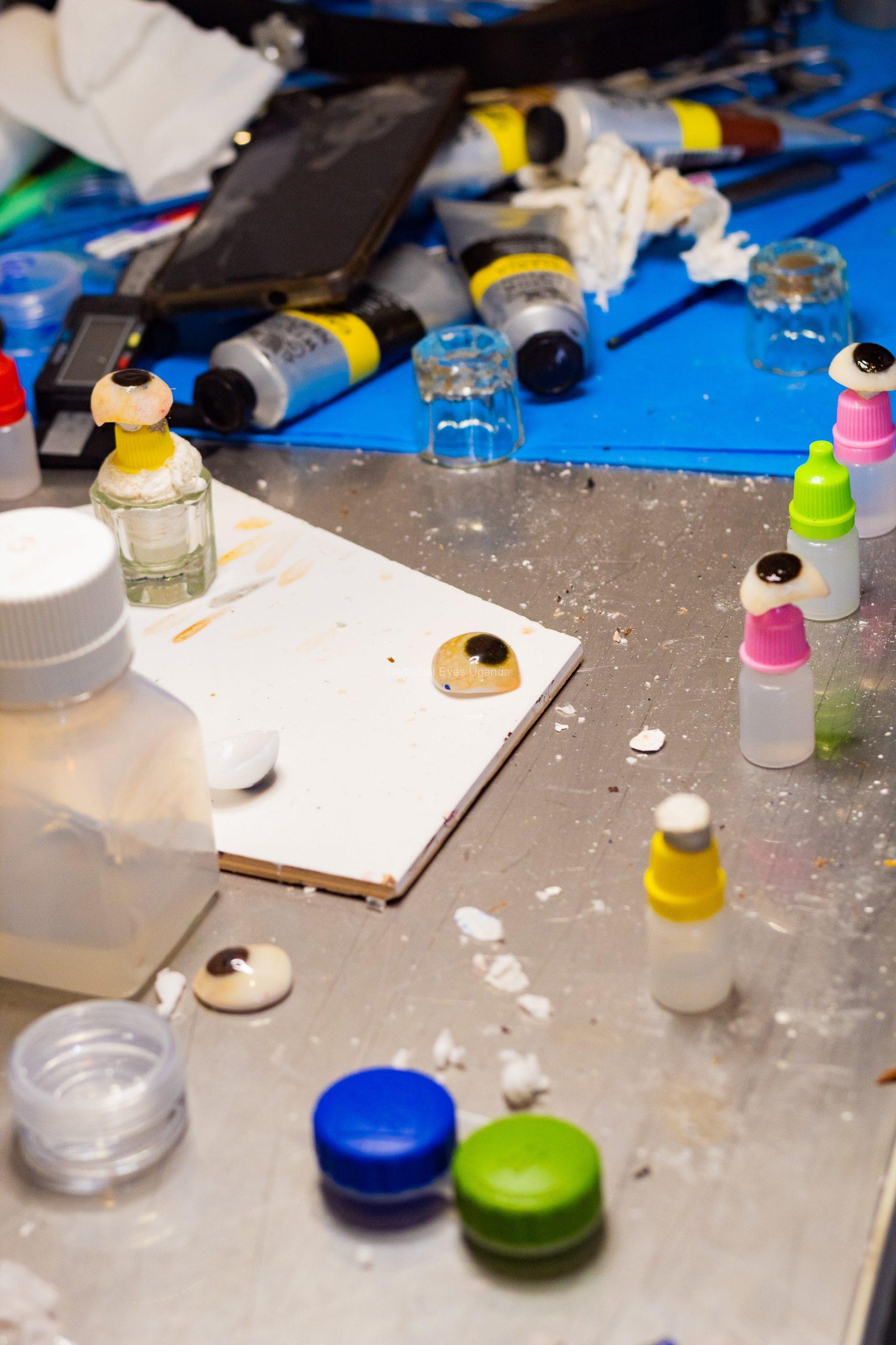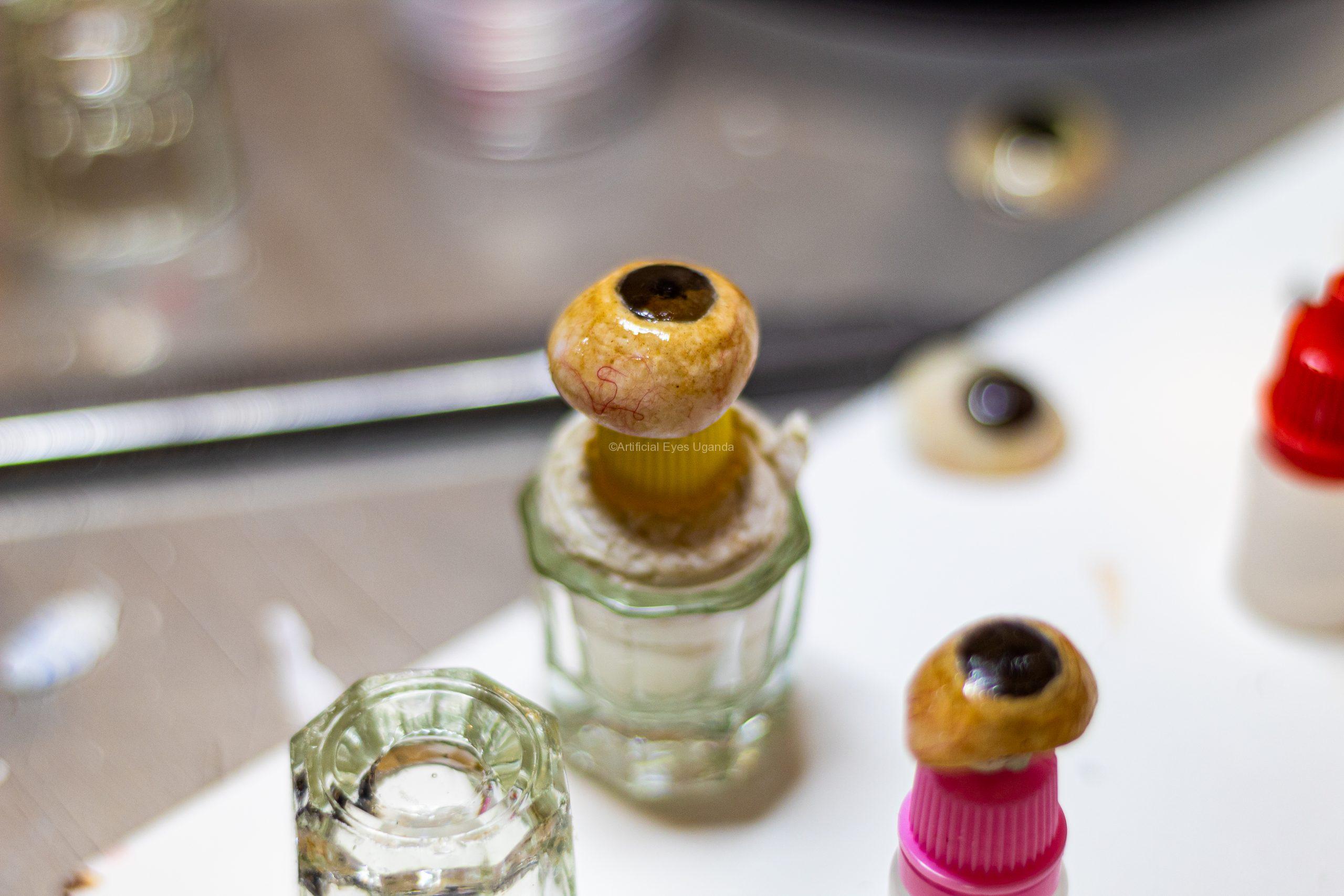Care
HANDLING YOUR OCULAR PROSTHESIS
Always use clean hands when handling your prosthesis. Check your surroundings to make sure the prosthesis won’t be damaged or lost if it is accidentally dropped. Remove the prosthesis only as necessary to clean or as often as directed. Too much handling can cause irritation to your socket and excess drainage.
REMOVING AN ARTIFICIAL EYE

- Pull down the lower eyelid with the index finger, look up and slide finger towards the ear.
- Allow the prosthesis to slide out over the lower lid. Gently remove prosthesis with the free hand.
WITH SUCTION CUP:

- Open eyelids, apply a suction cup to the prosthesis and squeeze the handle. When attached, relax the squeeze, holding handle lightly.
- Pull down lower with a finger. Tilt the prosthesis up and out, over the lower lid. Squeeze suction cup handle to release.
INSERTING AN ARTIFICIAL EYE WITH FINGERS:

- Lift upper lid with index finger to create an opening. Gently slide top edge of prosthesis under upper lid.
- Release upper lid once prosthesis is in. Pull down lower lid and blink until prosthesis sets into position.
INSERTING AN ARTIFICIAL EYE WITH SUCTION CUP:

- Attach a suction cup to the prosthesis by squeezing handle. Lift the upper lid and slide the top edge of the prosthesis under the upper lid.
- Release upper lid and pull down lower lid to seat prosthesis. Squeeze suction cup handle to release. Blink eyelids.
CLEANING YOUR OCULAR PROSTHESIS
Over time, the surface of the prosthesis collects protein and debris. Taking good care of your prosthesis helps to ensure a healthy socket and increase the life of your prosthesis.
Some patients find that removing and cleaning their prosthesis every day is necessary, while others are able to wear it for a couple of weeks or longer before cleaning.
- Wash hands with soap and warm water.
- Use warm water to rinse and softly scrub the prosthesis with your fingers, removing built-up protein and debris.
- Only use soap when necessary – on these occasions, use a mild soap like baby shampoo and rinse thoroughly.
- Dry with a soft tissue, polishing very lightly in a circular motion.
To remove built-up protein from your eyelids and eyelashes, soak with a warm wet tissue. It is also possible to clean the front of your prosthesis this way, without removing the prosthesis.
A professional polish is the only way to remove the protein attachments and bacterial infiltration. We recommend having your prosthesis polished every 6 months, depending on your body chemistry.
Care of an Artificial Eye and Related Information
Our artificial eyes are made of the finest quality of acrylic (methyl methacrylate resin) which has been proven by use in dentures as well as in plastic eyes, beginning in 1939. We have made sure no irritating substances can be present in the finished prosthesis by the choice of materials and by our handling.
The shape of the eye has been fitted to the shape of the patients’ eye socket by our exacting MODIFIED IMPRESSION METHOD for your best possible comfort, eye movement and life-like appearance. It has been colored by a special method devised by us to match as accurately as possible the color and character of the companion eye and to give the appearance of living tissue.

GETTING USED TO THE PROSTHESIS
Most people become accustomed to the wearing of the artificial eye within a few hours and eventually many are not aware of its physical presence.
There are a few exceptions as, for instance, persons who completely lack tears to lubricate the under surface of their eyelids. From the beginning, such person will need some type of artificial lubricant, as will be discussed later in some detail.
INDIVIDUAL REACTIONS TO PROSTHETIC EYES
Each artificial eye wearer is an individual and can react differently from others. Some people who have been wearing artificial eyes for some time like to give advice to new wearers. They can only report what they have been told by someone else or what they have learned about their own individual cases.
Do not follow any advice offered by another eye wearer without consulting your ocularist or ophthalmologist or both, because such advice might be completely wrong for you.
HOW LONG SHOULD YOU WEAR THE EYE BEFORE REMOVING IT FOR CLEANING?
The answer to this common question varies with the individual at least as much as those for other questions. No two people react the same way to the presence of the artificial eye.
In our opinion, you should discover by trial how long you can go. Wear the eye as long as it is not irritating and as long as it does not have material stuck to its front surface. After some experience, you may be able to anticipate discomfort and clean the eye just before it would begin to cause trouble.
Many of our patients wear their eyes, without removal for cleaning, for one year – between return visits for eye socket reevaluation and prosthesis polishing.
Scleral shell patients may require removal every night.

TO REMOVE THE PROSTHESIS FROM THE EYE SOCKET
A. Wash and rinse hands thoroughly.
B. Face mirror (if this is over a lavatory, throw a towel over all hard surface – as illustrated in figure 2A). Tilt the head slightly downward while looking at the artificial eye in the mirror; this rotates the prosthesis into a favourable position for removal. Hold one hand, palm upward and heel against the mouth, below the eye socket to catch the prosthesis if it comes out suddenly.
C. Place the forefinger of the other hand against the middle of the lower lid, close to the eyelashes and parallel to them. Press the lower lid tissues backwards until the lid margin goes under the lower edge of the artificial eye as indicated by the arrow at (a). At the same time, pull the finger sidewise toward the cheekbone as indicated by the arrow at (b) to stretch the lid margin under the bottom edge of the prosthesis, exposing it to view. The effect will be like an edge of a button coming through a buttonhole.
D. If the artificial eye does not slide out of the socket by itself, the cupped hand may be taken away from the cheek and its forefinger and thumb used to grasp from under the upper lid. After removal, the eye should be rinsed or washed, being careful not to drop it down any drain.
CLEANING THE EYE
Never wash or dry the eye with any kind of cloth because it will slowly wear away the polished surface, creating a dull, non-lifelike appearance.
With the prosthesis already out of the socket, as described earlier, make your hands soapy with a mild hand soap such as Ivory or Palmolive and pick up the eye carefully because it will be slippery. Rub it vigorously with pressure from the tips of your soapy fingers. The water used can be as hot as the hands can stand–it could actually be hotter without harming the eye.
Rinse all soap from the eye and hands. Pat the surface of the eye dry with soft facial tissue and check the surface to be sure there is not a thin film of material still stuck to it. If there is, the surface of the film will appear dull and you must repeat the cleaning process.
TO REPLACE THE PROSTHESIS IN THE EYE SOCKET
A. Wash hands. Face a mirror. If it is above a lavatory or other hard surface, drape a towel over that surface so that if the prosthesis is accidentally dropped, it is not likely to be damaged.
B. Hold the artificial eye by one hand in such a manner that the upper edge of the eye is upward and the back of the eye is toward the empty socket. One way to hold it is between the thumb and the second finger with the forefinger against the front of the cornea (over the pupil) as illustrated.
C. Lift the upper lid with a finger or the thumb of the free hand and keep the socket widely exposed for the next step.
D. While watching in the mirror, slide the upper edge of the prosthesis up under the upper lid. Gradually, work it higher under the lid until most of the pupil and iris are hidden. Do not let it slide down again until after the next step.
E. Release only the upper lid and bring the finger, which was holding it, around the front of the prosthesis to press it backwards and keep it under the upper lid. Release the prosthesis from the grip of the finger and thumb of the other hand and bring the later down to roll the lower lid margin out from under the bottom edge of the eye.
F. When the lower lid is definitely out in front of the prosthesis, move it around until it seems that the artificial eye is seated in its proper place. Take both hands away from the eye slowly, being ready to catch the prosthesis if it has not been correctly placed and falls out. (Falling onto coarse, sharp or hard surfaces can ship or scratch the plastic eye.)
Sometimes the difficulty in removing and placement of the artificial eye may be aided with the use of a suction cup. These can be obtained by contacting our office.
REASONS FOR DEVELOPMENT OF DISCOMFORT AND MUCOID DISCHARGE
A few sockets which are perfectly comfortable in the beginning can become uncomfortable after a period of time. There are several conditions, any one or any combination of which can cause these changes. You should make a special point of remembering the following list of causes of discomfort and mucous discharge for the remote possibility that one or more might develop, and remember the steps to be taken to correct them.
1. ROUGH-BUILD UP OF MUCOUS ON THE EYE
Some persons whose eyelids do not close completely over the artificial eye during sleep will have a partially dried film of ‘matter’ on the front of the eye when they wake in the morning.
Sometimes this can be cleared off without removing the eye by rubbing it with a rolled up tip of good quality facial tissue or q-tip moistened with warm water. Never use any kind of cloth for the reason already given, that it can dull the surface of the eye.
A few persons whose eyelids do close completely start as such a thin film that it can hardly be seen. This can make the surface of the eye just rough enough to irritate the underside of the eyelids as they blink. One should think of the possible presence of such a film if the eye socket is irritated with a scratching, burning or itching sensation.
The eye should be removed and carefully but thoroughly cleaned in such instances, in the manner described earlier.
2. FOREIGN BODIES UNDER THE EYELIDS
An eyelash can come loose or be broken off and be carried into the eye socket while replacing the eye. Dust or larger particles can blow into the eye socket. All can cause discomfort requiring the removal and probably rinsing of the socket.
3. LOSS OF SURFACE POLISH OR DEEPER SCRATCHES ON THE PROSTHESIS
Dust in the air can get into the tear film and the scrubbing action of the eyelids during blinking can reduce the polish of the surface of the plastic. Accidental scratching of the front surface, even while the eyes are in the eye sockets, has happened for many persons. Dropping the eye onto hard, rough surfaces can cause irritation to the underside of the eyelids (scratches or chip in plastic).
The eyes must be re-polished to correct the problem. We recommend that the eyes be polished once each year to maintain comfort to the eye socket tissues and reduce any discharge if present. If cracked or chipped, remove and call the Ocularist for repair. Never try to smooth the plastic yourself as excessive material may be removed and cause a greater cost to repair.
4. BACTERIAL AND VIRUS INFECTIONS
You must remember that the socket tissues around the artificial eye can become infected at least as easily as the companion, living eye. Discomfort and yellow-greenish discharge might indicate infection. Your tear duct (drainage) may be closed.
Your ophthalmologist must be consulted in such instances.

We recommend that the eye be polished at yearly intervals or as needed. This also affords the opportunity to check the eye socket and judge whether the back of the eye is still fitting the tissues of the socket properly. Do not ever allow a dentist to re-polish the eye. Do not have any eye fitter except one we might recommend polishing the eye. This is to guarantee that the shapes we have so carefully built into your eye for proper fit are not changed.
NEED FOR REFITTING THE EYE
Occasionally, not all the edema is gone from the orbit at the time of an original prosthetic fitting. As the edema disappears, which may take several months to a year, the artificial eye may sink deeper in the eye socket and the upper eyelid may droop over the eye. Whenever this becomes noticeable it would be best to add material to the eye beginning with a new impression taken on the back of the prosthesis.
As already noted earlier, slow atrophy of fat from deep in the orbit can require the same kind of refitting as above.
Occasionally, a person will have a sudden extreme loss or gain of body weight which will be accompanied by sinking back or other changes in the socket of the eye, requiring refitting of the prosthesis (commonly occurring during pregnancy).
WHEN TO CONSULT EITHER YOUR OPHTHALMOLOGIST OR YOUR OCULARIST
It is best to consult your eye doctor with any noticeable increase in tearing from the eye socket, with any marked loss or reduction of comfort, with excessive persistent mucoid discharge or with an easily recognized bulging out of the artificial eye. If there is an implant present, bulging could indicate extrusion or migration and should call for immediate attention. If your ophthalmologist feels a problem is one for the ocularist, he or she will suggest returning for a checkup on the prosthesis.
Sinking back of the eye so that the eyelids no longer open properly or tilting into an abnormal direction of the prosthesis is reasons to see the ocularist.
The ocularist might be helpful in suggesting lubricants if they may be needed. Some problems require the cooperative efforts of both the doctor and the ocularist. Call if you have any questions.

IMPORTANT POINTS TO REMEMBER AND WARNINGS
1. If the eye bothers so that it must be wiped or rubbed, always close the eyelids and wipe toward the nose. Wiping away from the nose can often cause the eye to fall out or rotate.
2. Never leave the eye in a piece of facial tissue. Several left in this way for just minutes have been picked up and thrown away. Some have been burned with the waste papers.
3. If you swim or dive in the water, either wear a protective patch or swimming goggles – or remove the eye and store it safely. More eyes have been lost during these sports than in any other way.
4. Cold weather, dry weather and wind tend to make artificial eyes uncomfortable. Some lubricating eye drops may reduce or relieve this discomfort.
5. Never expose the artificial eye in any way to alcohol, ether, chloroform, some hair sprays, or any other solvents. These can damage the eyes beyond repair.
6. Be sure to remove the prosthesis before having any general anaesthetic for surgery. Some of the anaesthetics can damage the surface of the plastic, requiring expensive reprocessing or even replacement with a new eye. Others have been lost by the hospitals.
7. Always practice extreme cleanliness when handling your prosthetic eye. If your eye should happen to fall out, be sure to rinse it thoroughly and then wash it with soap and water before reinserting it.
8. Consult your doctor immediately if trouble you do not understand arises.
9. Have your eye checked and polished once a year to keep it in the very best condition. Do not let anyone other than ourselves, or someone we recommend, polish your eye. Polishing compounds used by many eye fitters, dentists, opticians and others will not polish as highly as necessary for greatest comfort. Also, the technician must take care not to change the contours of the eye, which might result in a poor fit.
10. Wear your protective glasses from the minute you have finished washing your face in the morning until you go to bed at night. Even when you are alone and least expecting it, an object can fly at your remaining eye. YOU NO LONGER HAVE A SPARE EYE. Protect the one you have.
11. Have your ophthalmologist check your good eye at least once each year.
12. As long as you are perfectly comfortable and the eye still looks fine, do not do anything between yearly check and polishings. Except for slowly changing appearance which you might not be aware of, if your eye needs care, it will let you know.
13. Never put the artificial eye in your mouth because it can cause choking and may lead to death.

ABOUT US
We take great passion in creating solutions that can give you so much confidence and encouragement in a situation that can at times be very difficult. We are all highly motivated professionals, constantly working to produce prostheses, the best each time we do it. We remain well connected with those in our industry, to evolve in the best we can be while learning from others.
FOLLOW US
ALL CONTACTS
- Queen's Road, Entebbe
- +256754077479
- contact@artificialeyesuganda.com
- Only On Appointment
- P.O.Box 738, Entebbe, Wakiso, Uganda
- Artificial Eyes - Copyright 2021







